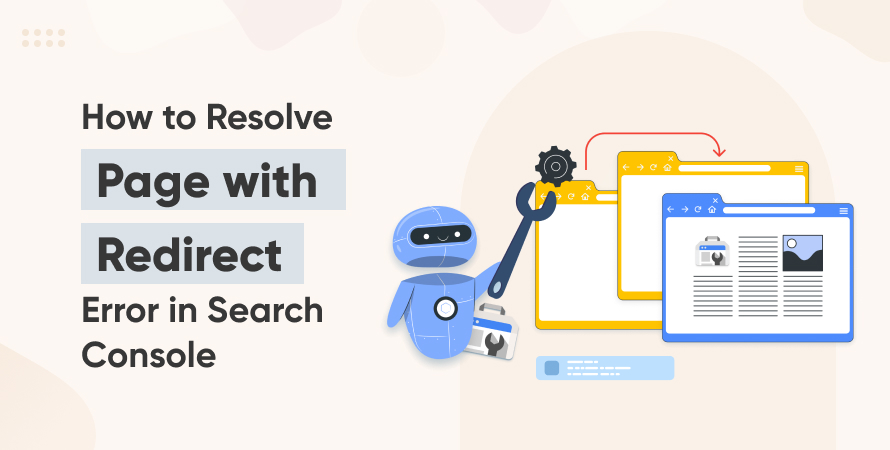How to Resolve “Page with Redirect” Error in Search Console



Introduction
Encountering a “Page with redirect” status in Google Search Console (GSC) can leave website owners confused about whether it’s a genuine issue or simply a technicality. While not always indicative of a major problem, ignoring this alert could harm your website’s visibility, user experience, and SEO performance over time.
In today’s competitive digital marketing landscape, understanding how URL redirection affects your site’s health is more crucial than ever. This guide explores the common causes, diagnostic techniques, and effective solutions for resolving redirect errors flagged in Google Search Console—ensuring your site stays search-friendly and fast-loading.
Understanding Redirects: The Basics
Before addressing the error, it’s important to understand website redirects. A redirect automatically sends users and search engines from the original URL they requested to a different one. Redirects help manage URL changes, site migrations, or content updates, ensuring visitors reach the correct page without errors, maintaining SEO value and a smooth user experience.
Types of Redirects:
- 301 Redirect (Permanent): Tells search engines that a page has permanently moved to a new location.
- 302 Redirect (Temporary): Informs that the move is temporary.
- 307 Redirect: A more specific type of temporary redirect, mostly used in HTTP/1.1.
- Meta Refresh: Often used on the page itself and is not ideal for SEO.
- JavaScript Redirects: Rely on browser execution and can be less reliable for crawlers.
Redirects play a vital role in digital marketing agency strategies, especially during website migrations, URL structure changes, or campaign launches. However, improper use can lead to crawl errors, reduced page speed, and visibility issues.
What Does “Page with Redirect” Mean in Google Search Console?
When Google Search Console labels a URL as “Page with redirect,” it means the URL submitted in your sitemap or discovered during crawling doesn’t serve content directly. Instead, it redirects users and search engines to a different URL.
Why This Matters:
- Google may decide not to index the redirected URL, which can affect how your site appears in search results.
- A website’s redirected pages might not pass link equity effectively, potentially impacting your SEO rankings.
- Excessive or incorrect use of redirects can cause crawl inefficiencies, making it harder for Google to properly index your site.
This message isn’t always a cause for concern, especially if the redirect is intentional and correctly set up. However, if you notice this error unexpectedly or for URLs that should serve content directly, it’s important to investigate and fix the issue promptly to maintain your website’s SEO health and ensure a smooth user experience.
Common Causes of the “Page with Redirect” Issue
Several factors can lead a “Page with redirect” on Google Search Console. Understanding these helps you diagnose the problem more effectively.
Common Culprits:
- Redirect Chains: When multiple redirects are involved before reaching the final destination, causing delays and crawl inefficiencies.
- Redirect Loops: Endless redirections that trap both users and search engines.
- Incorrect HTTP to HTTPS Transitions: Mismatched protocols or redirects without proper canonical settings.
- Improper Use of JavaScript or Meta Refresh: These redirects may not be interpreted properly by bots.
- CMS or Plugin Misconfigurations: Automated redirects by CMS platforms like WordPress or SEO plugins can create unintended behavior.
A site redirect should ideally be a single, direct hop. Anything beyond that introduces complexity and potential SEO drawbacks. Mismanaged Google redirects can lead to indexing issues, loss of link equity, and crawl inefficiencies.
How to Identify Redirect Issues on Your Website
The first step to resolving the “Page with redirect” error is to pinpoint where the problem exists on your website. Identifying the exact URLs causing issues allows you to take targeted action and improve your site’s performance and SEO.
Tools to Trace Link Redirects:
- Google Search Console: Use the Page Indexing Report to identify URLs flagged with redirect issues.
- Chrome DevTools (Network tab): Monitor HTTP status codes and track the exact redirection paths as users and bots navigate your site.
- Screaming Frog SEO Spider: A powerful desktop crawler that helps visualize redirect chains and detects problematic loops or chains.
- Redirect Path Chrome Extension: Quickly displays redirection headers and status codes directly in your web browser for any URL.
- HTTP Status Code Checkers: Online tools that provide fast inspection of URL behavior and status codes.
Conducting regular audits using these tools is critical, especially if you’ve recently partnered with a digital marketing agency for website redesigns, migrations, or content restructures. These audits help ensure redirects are properly configured and avoid unexpected SEO issues.
Step-by-Step Guide to Fixing “Page with Redirect” Errors
Here’s a practical guide to solving the issue efficiently:
Step 1: Audit All Redirects
Use tools like Screaming Frog or Sitebulb to crawl your website and generate a list of URLs returning 3xx status codes. Identify redirects that create multiple hops or point to broken URLs. This audit reveals the scope of redirect issues needing correction.
Step 2: Remove or Flatten Redirect Chains
Redirect chains occur when a URL redirects through multiple intermediate pages before reaching the final destination. Flatten these chains by ensuring the initial URL points directly to the final target, improving site speed and crawl efficiency for both users and search engines.
Step 3: Update Internal Links
Check your website’s internal links and replace any that point to old or redirected URLs. Linking directly to the final destination avoids unnecessary redirects, reducing load times and ensuring better SEO performance by passing link equity effectively.
Step 4: Choose the Right Redirect Type
Use Google redirect 301 for permanent URL changes to transfer link authority properly. Avoid using 302 redirects unless the move is temporary. Consistent use of correct redirect types helps search engines understand your site structure and improves SEO results.
Step 5: Validate in Google Search Console
After implementing fixes, go to Google Search Console and mark the redirect issues as “Fixed.” Re-submit your sitemap to encourage Google to re-crawl the updated URLs, helping to verify that the problem has been resolved.
Step 6: Monitor Performance
Keep track of your site’s Indexing Status and Core Web Vitals metrics after fixing redirects. Improvements in indexing and page performance indicate successful resolution of redirect errors and contribute to better SEO and user experience.
Advanced Tips for Better Redirect Management
Beyond basic fixes, optimizing redirect handling involves a deeper understanding of technical SEO and user behavior.
Canonical Tags vs Redirects
Canonical tags suggest the preferred version of a page to Google, whereas redirects enforce it. Use canonical tags for slight content variants, and redirects for complete replacements.
Handling Cross-Domain Redirects
Ensure HTTPS certificates are valid, and headers are correctly configured. Track referrer loss during analytics reviews.
JavaScript Redirect Caution
JavaScript-based redirects can delay indexing. Use only when absolutely necessary and ensure the redirected content is crawlable.
Mobile vs Desktop Redirects
Avoid user-agent-based redirects unless critical. Always serve the same URL for both devices whenever possible.
Leverage Server Log Files
Analyze web server logs to see how bots interact with your redirects. This gives insight into crawl frequency and redirect loops undetected by tools.
Impact of Redirect Errors on SEO and Core Web Vitals
Redirect chains and loops directly affect site speed and SEO performance.
SEO Consequences:
- Loss of link equity reduces the authority passed between pages, weakening SEO strength.
- Poor crawl efficiency occurs when Googlebot wastes time navigating multiple redirects, limiting site coverage.
- Lower indexation rates result as important pages may be missed or delayed in indexing.
Impact on Core Web Vitals:
- Largest Contentful Paint (LCP): Redirects increase load times, delaying main content visibility.
- First Input Delay (FID): Redirect chains slow interactivity, causing longer delays before users can engage.
- Cumulative Layout Shift (CLS): Slow-loading redirects can cause unstable layouts, harming user experience.
Hiring an experienced Core Web Vitals consultant can help you:
- Audit redirect issues holistically
- Improve site performance and user experience
- Ensure your website aligns with Google’s performance expectations
Preventing Redirect Errors in the Future
Being proactive with redirection strategies can prevent most issues from occurring.
Best Practices for Managing Redirects:
Use relative paths whenever possible to simplify URL management and reduce errors.
- Avoid linking to URLs that already redirect; link directly to the final destination to improve efficiency.
- Keep your .htaccess and Nginx server rules regularly updated to ensure redirects function correctly.
- Limit reliance on plugins for critical redirects, as they can introduce unexpected issues or conflicts.
- Conduct quarterly SEO audits in collaboration with your digital marketing agency to identify and fix redirect problems proactively.
- Incorporate thorough documentation and testing into your deployment pipeline to catch and resolve redirect errors before changes go live, ensuring a smoother user experience and better SEO outcomes.
Conclusion
Redirects are an essential part of web infrastructure but must be handled with precision. The “Page with redirect” error in Google Search Console is a warning signal—one that shouldn’t be ignored if you value search visibility and site performance.
A disciplined redirect strategy contributes to faster load times, smoother indexing, and better user experience. Whether you’re running an eCommerce site, a SaaS platform, or a digital marketing blog, the cost of mismanaging redirects is far greater than investing in getting them right.
Need expert guidance on optimizing redirects and improving Core Web Vitals? Hire Core Web Vitals consultants with hands-on experience in solving complex redirect issues and enhancing your website’s technical SEO foundation.
Frequently Asked Questions (FAQs)
A 301 redirect indicates a permanent change, passing most link equity. A 302 is temporary and may not pass SEO value, so it’s best used sparingly.
Yes. If redirects are misconfigured (e.g., loops or long chains), they can lead to crawl issues, slow loading, and reduced ranking potential.
Use tools like Chrome DevTools, Screaming Frog, or the Redirect Path extension to map the full redirection journey of any URL.
Yes. Excessive redirects increase latency and degrade Core Web Vitals, especially Largest Contentful Paint (LCP).
The page may return a 3xx status that redirects to another page. Even if it functions for users, Google may treat it differently for indexing purposes.